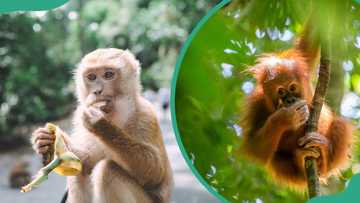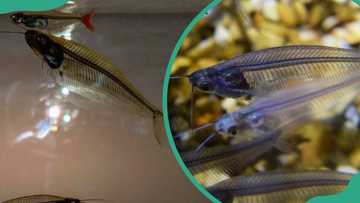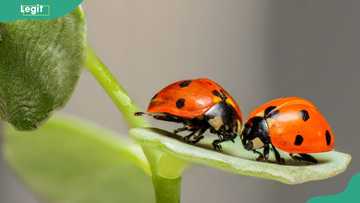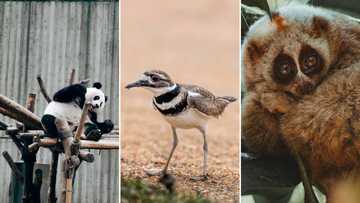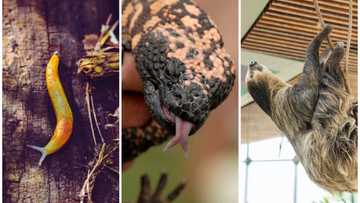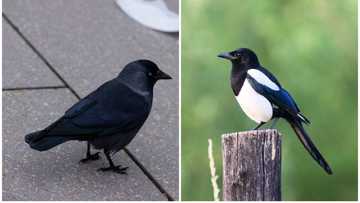30+ facts about butterflies: interesting fluttering tidbits
The butterflies' tidbits’ brightly coloured bodies and effortless motion make them adorable creatures. In addition to their stunning beauty, butterflies play a crucial role in maintaining healthy and diverse plant life through their pollination activities. Here are some fun facts about butterflies that you can share with your students, friends and family. Professor David James, an Associate Professor of Entomology at Washington State University (WSU), shares expert insights into the lifespan of butterflies, their critical role in ecosystems, and the environmental threats they face today.
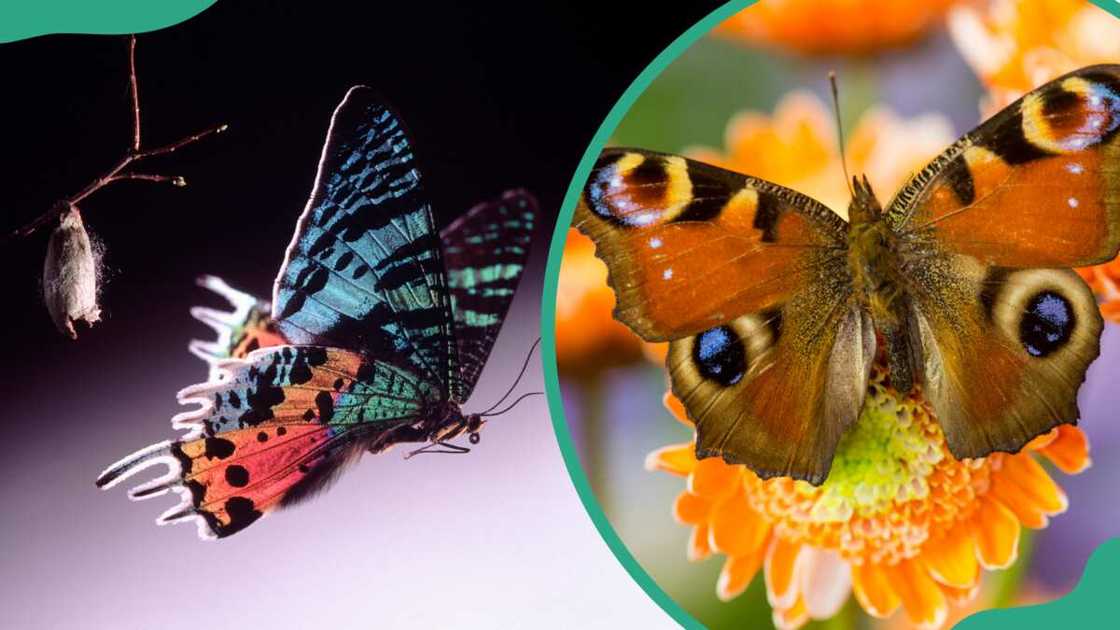
Source: Getty Images
TABLE OF CONTENTS
- 30+ facts about butterflies
- 1. Super speedsters
- 2. Taste with their feet
- 3. Liquid diet
- 4. Cold-blooded beauties
- 5. Transformation masters
- 6. Mimicry magic
- 7. Short lifespan
- 8. Diverse diets
- 9. Migratory marvels
- 10. Colourful vision
- 11. Silent flyers
- 12. Wing scales
- 13. Camouflage experts
- 14. Sensory antennae
- 15. Superb survival tactics
- 16. Lepidoptera legacy
- 17. Egg variety
- 18. Caterpillar growth spurt
- 19. Temperature-dependent
- 20. Ancient creatures
- 21. Global presence
- 22. Communal roosting
- 23. No mouths in youth
- 24. Diverse family
- 25. Pheromone producers
- 26. Crystal clear
- 27. Eternal symbols
- 28. Nocturnal counterparts
- 29. Wing regeneration
- 30. Hydration hunters
- 31. Eye spots illusion
- 32. Sun worshippers
- 33. Migration mysteries
- Surprising facts about butterflies
- Ecological importance of butterflies
- Are there any specific environmental threats currently affecting butterfly populations worldwide?
- What do butterflies eat?
- What is the life cycle of a butterfly?
- Where do butterflies live?
- What are the cool abilities of a butterfly?
- What makes a butterfly special?
If you are a teacher or enjoy learning new things, butterfly facts are a great way to excite students about insects. They can learn about metamorphosis, pollination, and many other fascinating topics through these fun facts.
30+ facts about butterflies
Butterflies are unique insects, and there is a National Butterfly Day! Its official name is National Learn About Butterflies Day, and it’s held on 14 March to celebrate these tiny living jewels. Check out these fascinating facts about butterflies you probably did not know.
1. Super speedsters
This is one of the facts about butterflies for kids that you can share in the classroom. These living jewels might look delicate, but some can fly at speeds of up to 30 miles per hour. This rapid flight helps them evade predators and cover large distances for food.
2. Taste with their feet
Butterflies use their feet to taste by helping them find the best plants for their caterpillars. When a female butterfly lands on a leaf, she can sense whether it suits her eggs through chemoreceptors on her tarsi.
3. Liquid diet
According to the Smithsonian Institution, butterflies primarily feed on liquid nectar, using their long tube-like tongue called a proboscis to sip it. This straw-like tongue uncoils to reach deep into specific flowers by allowing them to access nectar that other insects might not reach. Some butterflies also feed on tree sap, rotting fruit, and even animal dung.
4. Cold-blooded beauties
As ectothermic creatures, butterflies need the sun to warm up their bodies before they can fly. They often bask in the sunlight, spreading their wings to absorb heat. Without sufficient warmth, their muscles cannot generate the necessary energy for flight, making them easy prey for predators.
5. Transformation masters
According to The Academy of Natural Sciences of Drexel University, the metamorphosis from caterpillar to butterfly is one of the most incredible transformations in nature. Inside, the caterpillar's body breaks down into a liquid form and reconstitutes into a butterfly. This process takes anywhere from a few weeks to several months.
6. Mimicry magic
Some butterflies can mimic the appearance of other, more dangerous animals to avoid predators. For example, the Viceroy butterfly resembles the toxic Monarch butterfly.
7. Short lifespan
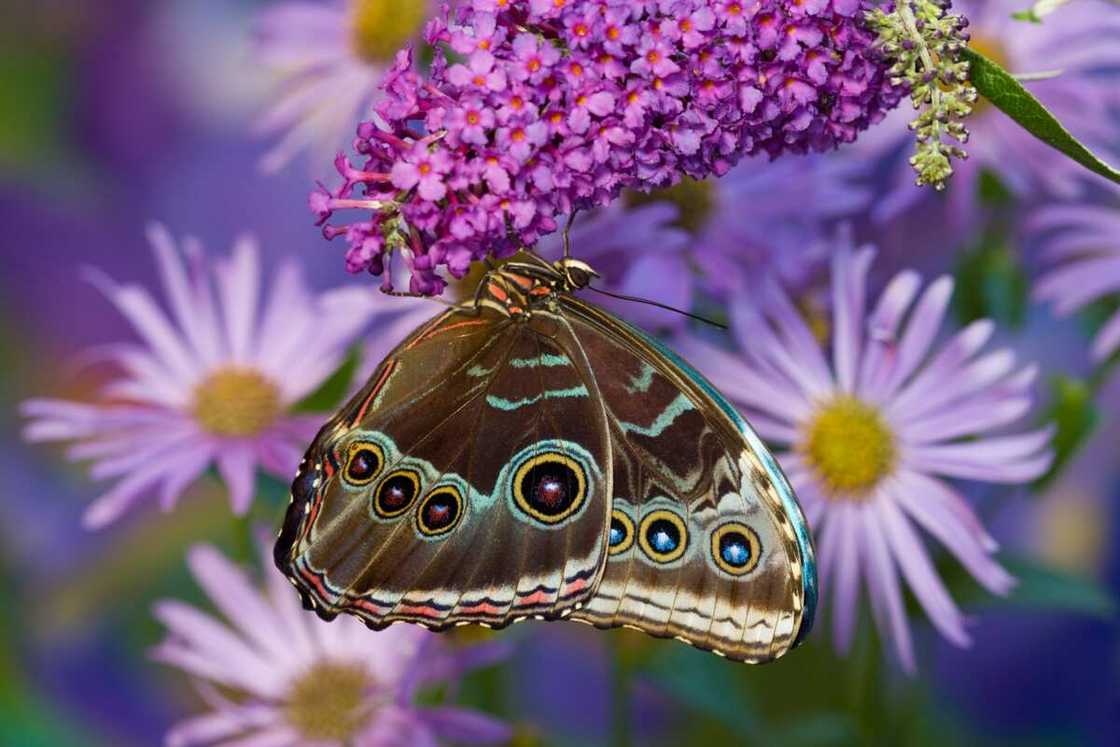
Source: Getty Images
Most adult butterflies live only for a few weeks, though some species can survive for several months. Monarchs, Mourning Cloaks, and tropical Heliconians can live up to nine months.
8. Diverse diets
Most adult butterflies drink nectar from flowers, but some also feed on tree sap, rotting fruit, and animal dung to obtain essential nutrients.
9. Migratory marvels
According to Monarch Watch, the Monarch butterfly is famous for its long migration, travelling thousands of miles from North America to Central Mexico. This journey, which can span multiple generations, is guided by environmental cues like the sun's position and magnetic fields.
10. Colourful vision
These tiny insects can see various colours, including ultraviolet, which is invisible to the human eye. Their complex eyes comprise thousands of tiny lenses, providing a broad field of vision. This advanced sight helps them locate flowers, mates, and potential threats accurately.
11. Silent flyers
Butterflies do not make any noise while flying because they do not have vocal cords or produce sound through their wings. Their flight is silent and graceful, making it difficult for predators to detect them. This quiet flight also aids in their stealthy approach to flowers for feeding.
12. Wing scales
A butterfly’s wings are covered in tiny scales, giving them vibrant colours and patterns. These scales overlap like shingles on a roof and can produce iridescent effects. The scales also help regulate body temperature and provide protection from environmental damage.
13. Camouflage experts
Some butterflies can blend perfectly into their surroundings to avoid being eaten by predators. Their wing patterns and colours often mimic leaves, bark, or flowers. This camouflage provides them with an effective means of avoiding detection while resting or feeding.
14. Sensory antennae
These insects use their antennae for balance purposes and smelling the world around them. The antennae have sensory organs that can detect pheromones and other chemical signals. This helps butterflies locate food, mates, and suitable habitats.
15. Superb survival tactics
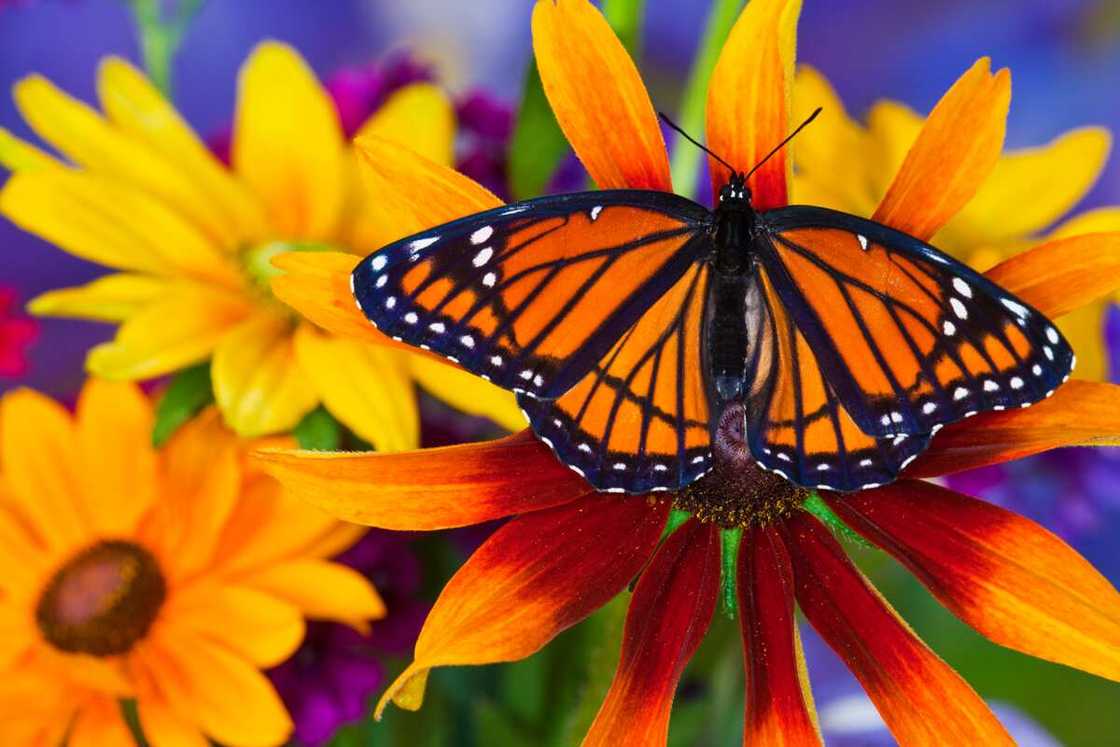
Source: Getty Images
Certain butterfly species have eyespots on their wings to scare off potential predators. These spots can mimic the eyes of larger animals, making predators think twice before attacking. The sudden display of these eyespots can startle and deter attackers, giving the butterfly a chance to escape.
16. Lepidoptera legacy
Butterflies belong to the order Lepidoptera, which also includes moths. This diverse group of insects is characterised by their scaled wings. Lepidoptera is one of the most significant insect orders, with around 180,000 species described worldwide.
17. Egg variety
Butterfly eggs can be round, cylindrical, or oval, depending on the species. These eggs are often laid on the underside of leaves to protect them from predators and environmental hazards. The shape and size of the eggs can also influence the survival rate of the larvae.
18. Caterpillar growth spurt
A caterpillar can grow 100 times its size between hatching and pupation. This rapid growth is fuelled by constant eating, often consuming leaves and plants at an impressive rate. During this stage, the caterpillar sheds its skin multiple times as it outgrows its exoskeleton.
19. Temperature-dependent
The temperature can influence the gender of some butterfly species during the pupal stage. Warmer temperatures may result in a higher proportion of females, while cooler temperatures can lead to more males. These living jewels cannot fly if their body temperature is less than 86 degrees.
20. Ancient creatures
Butterflies have existed for at least 50 million years, with some fossil records suggesting longer. These ancient insects have adapted to various environmental changes over millennia. Their long evolutionary history is evident in the diversity of species and behaviours observed today.
21. Global presence
As per Loughborough University, butterflies are found on every continent except Antarctica. They thrive in various habitats, from tropical rainforests to arid deserts. This widespread distribution highlights their adaptability and ecological importance.
22. Communal roosting
Some butterfly species roost together in large groups for warmth and protection. This behaviour, known as communal roosting, helps them conserve energy during colder months. It also provides safety in numbers, making it harder for predators to single out an individual butterfly.
23. No mouths in youth
Caterpillars don't have mouths; they have mandibles for chewing leaves. These strong jaws allow them to consume large amounts of vegetation, fuelling their rapid growth. After metamorphosis, they develop a proboscis for sipping nectar.
24. Diverse family
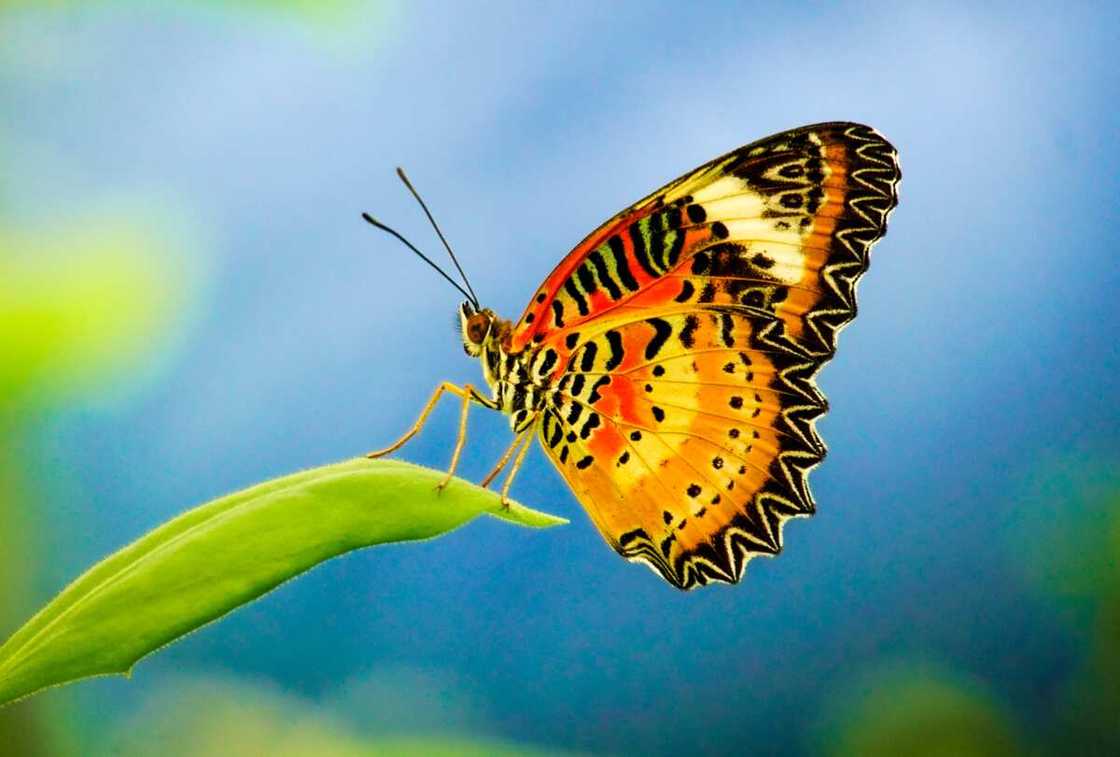
Source: Getty Images
There are approximately 20,000 species of butterflies worldwide. This vast diversity includes various sizes, colours, and behaviours. Each species has adapted to its specific environment, contributing to the rich tapestry of butterfly life.
25. Pheromone producers
Male butterflies produce pheromones to attract females during mating. These chemical signals are released into the air and detected by females through their antennae. Pheromones play a crucial role in the courtship process, ensuring successful reproduction.
26. Crystal clear
The wings of glasswing butterflies are transparent, providing excellent camouflage. This unique adaptation makes them nearly invisible in their natural habitat. The transparency is due to the microscopic structure of the wing scales, which reduce reflection and scatter light.
27. Eternal symbols
These insects often symbolise transformation, hope, and life in various cultures. Their metamorphosis from caterpillar to butterfly represents personal growth and renewal. In many traditions, butterflies are seen as messengers of change and symbols of the soul.
28. Nocturnal counterparts
While these living jewels are diurnal, their cousins, the moths, are typically nocturnal. This difference in activity patterns helps reduce competition for resources. Moths have evolved various adaptations, such as enhanced night vision, to thrive in the dark.
29. Wing regeneration
Butterflies cannot regenerate lost or damaged wings, making them more vulnerable to predators. Any injury to their wings can severely impact their ability to fly and evade threats. This underscores the importance of their delicate and intricate wing structures.
30. Hydration hunters
Butterflies drink from mud puddles to obtain salts and minerals, a behaviour known as "puddling." This practice is widespread among male butterflies, who need these nutrients for reproduction. Puddling provides essential electrolytes that are not found in nectar.
31. Eye spots illusion
The "eye spots" on some butterflies’ wings can deter predators by mimicking the eyes of larger animals. This visual trickery can make predators hesitate or flee, mistaking the butterfly for a more formidable creature. Eye spots are a brilliant example of evolutionary adaptation for survival.
32. Sun worshippers
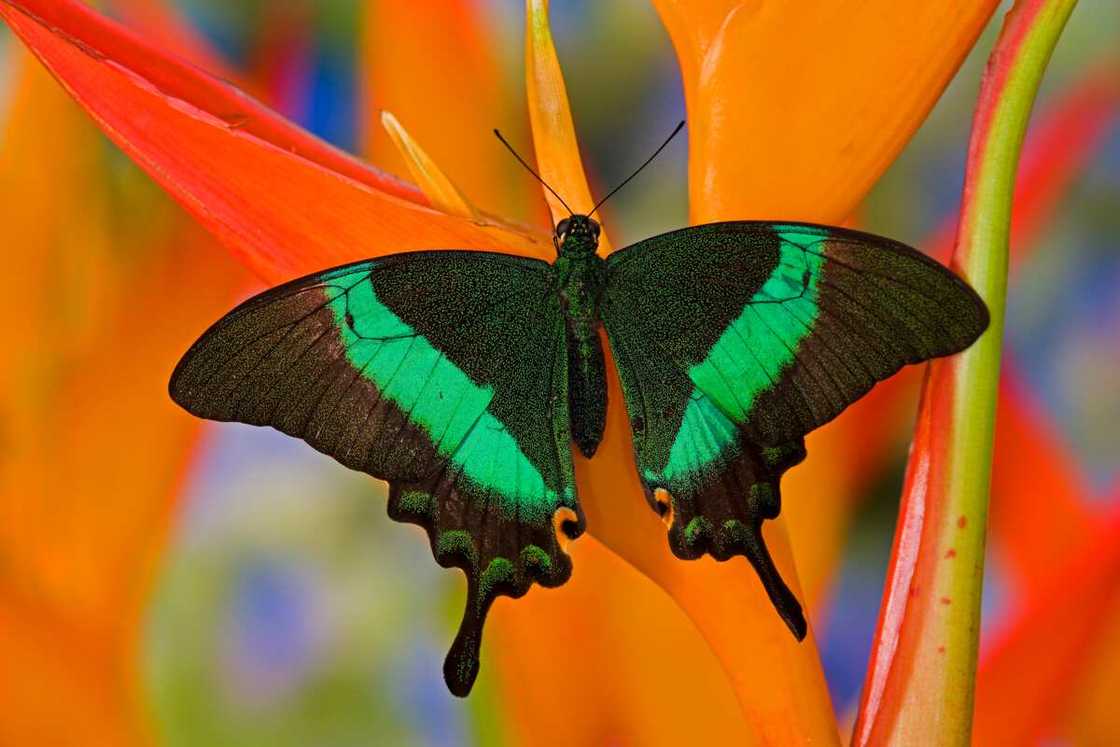
Source: Getty Images
These living jewels bask in the sun to regulate their body temperature and prepare for flight. This behaviour is essential for their ectothermic metabolism, which relies on external heat sources. Sunbathing also aids in digestion and overall physiological function.
33. Migration mysteries
Scientists are still unravelling how Monarch butterflies navigate their long migratory routes. These insects use a combination of environmental cues, such as the sun's position and the earth's magnetic field. Their incredible journey, spanning generations, remains one of nature's great marvels.
Surprising facts about butterflies
Professor David James, an Associate Professor of Entomology at Washington State University (WSU), explained in an interview that most people are astonished that some butterfly species can live up to a year and migrate thousands of miles. He said:
Most people think butterflies live for only days, but many species, particularly those that hibernate during winter or estivate in the hottest part of summer, can live for many months.
Butterflies can also be great travelers, migrating thousands of miles. The best examples are the Monarch butterfly, which flies every autumn from Canada to Mexico for overwintering, and the Painted Lady butterfly, which can migrate from Great Britain to Africa or even South America, as recent research has shown.
Professor James also addressed some common myths about butterflies. He said the biggest misconceptions are that they are fragile and don't live long and that if the scales on butterfly wings are rubbed off, the butterfly cannot fly. "This is not true, and butterfly wings are remarkably strong; they have to be to enable some butterflies to live for many months and fly long distances," he clarified.
Ecological importance of butterflies
Professor James highlighted some key points about why butterflies play an essential role in ecosystems, functioning as pollinators and food sources. He said:
Butterflies are an essential part of any ecosystem, providing pollination services and a vital food resource for many birds, reptiles, and mammals. In particular, butterflies' caterpillars are a critical food source for many insectivorous birds. In essence, butterflies and their immature stages (eggs, caterpillars, chrysalids) are key components of the food chain in most ecosystems, particularly temperate and tropical environments.
Adult butterflies spend their lives visiting flowers for nectar and are, in the process, essential pollinators. This is particularly true for many kinds of native plants, and recent research has also shown that some butterfly species can be significant pollinators in some crops, like beans.
Are there any specific environmental threats currently affecting butterfly populations worldwide?
Professor James identifies two significant challenges that butterflies face. They include:
- Habitat degradation or destruction: Without their habitats, butterflies cannot exist, and human industrial, agricultural, and urban development is reducing butterfly habitats at an alarming rate. From destroying temperate woodlands and meadows to tropical rainforests, millions of hectares of habitats of thousands of butterfly species are being lost annually.
- Pesticides impact: Pesticides in agricultural and urban environments affect butterfly populations. Professor James explains:
These chemicals either directly kill butterflies or produce 'sub-lethal' effects, slowly reducing populations over a few years. Many butterfly populations worldwide are at the lowest levels ever seen because of environmental threats. The Monarch butterfly in North America is a prime example of a more than 80-90% reduction in population recorded over the past two decades.
What do butterflies eat?
Butterflies primarily eat nectar from flowers using their long, tube-like proboscis. Besides nectar, some butterflies also feed on tree sap, rotting fruit, animal dung, and mineral-rich mud puddles to obtain necessary nutrients.
What is the life cycle of a butterfly?
The life cycle of a butterfly consists of four distinct stages: egg, larva (caterpillar), pupa (chrysalis), and adult butterfly.
Where do butterflies live?
Butterflies are found on every continent except Antarctica. They inhabit various environments, including forests, meadows, grasslands, deserts, wetlands, and even urban areas. These animals thrive in places where flowers are abundant, as these provide their primary food source, nectar.
What are the cool abilities of a butterfly?
These living jewels possess several fascinating abilities, including flying at speeds up to 30 miles per hour, camouflaging to avoid predators, and seeing ultraviolet light, which is invisible to humans.
What makes a butterfly special?
Butterflies are unique animals because, unlike many animals, they can transform from caterpillar to butterfly (metamorphosis). This remarkable process in nature symbolises change and renewal.
These facts about butterflies showcase their incredible diversity, unique adaptations, and significant roles in ecosystems worldwide. Understanding and appreciating these delicate creatures can inspire you to protect their habitats and ensure their survival for future generations.
Legit.ng recently published an exciting post about animals that start with E. The E animals offer a glimpse into the diversity of the natural world and play a vital role in maintaining a balance in the ecosystem.
When it comes to E animals, many first think of the elephant and the eagle, but the list of E animals is extensive. Read on to explore the enchanting exploration of the animal kingdom, explicitly targeting E animals.
Source: Legit.ng

Brian Oroo (Lifestyle writer) Brian has worked as a writer at Legit.ng since 2021. He specialises in lifestyle, celebrity, and news content. He won the Writer of the Year Award at Legit in both 2023 and 2024. Brian holds a BSc in Electrical and Electronics Engineering from Jomo Kenyatta University of Agriculture and Technology (JKUAT), earned in 2021. He completed the AFP course on Digital Investigation Techniques in 2023 and the Google News Initiative course in 2024. His email is brianoroo533@gmail.com

Mary Ugbodaga (Lifestyle Journalist) Mary Ugbodaga is a Legit.ng journalist with 7 years of experience in journalism and media communications. She graduated from Covenant University in 2018 with a Bachelor's degree in Mass Communication/Media Studies. Mary previously worked as a journalist at TheCable, CNBC AFRICA, Voice of Nigeria, KPMG Nigeria. Email: mary.ugbodaga@corp.legit.ng.



